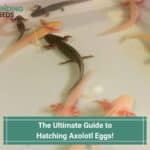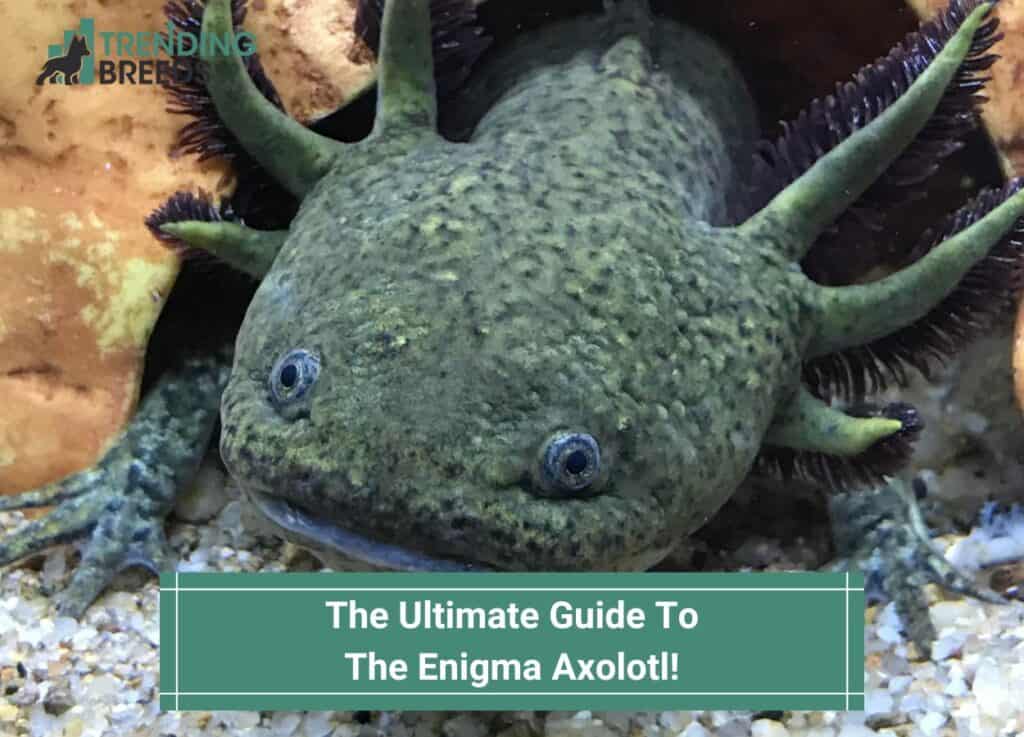
Axolotls exhibit various morphs and variants, each with unique characteristics. One particularly captivating variant is the enigma axolotl, renowned for its rarity and breathtaking beauty.
These enigmatic creatures are indeed a sight to behold, sporting an exquisite spectrum of colors ranging from golden yellow and gray to black, white, and even pink.
If you’re eager to delve deeper into axolotl diversity, this ultimate guide will enlighten you further. Read on to learn more.
Before you scroll further down this guide, check out these other animal-related articles: Rhodesian Ridgeback Pitbull Mix – Ultimate Breed Guide and Cane Corso Great Dane Mix – Ultimate Breed Guide.
Table of Contents
Origins of Enigma Axolotl
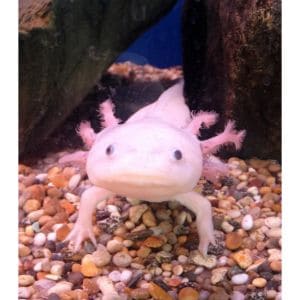
There are 15 axolotl morphs or variants, with one of them being the enigma variant.
True to its name, the enigma axolotl came about through pure chance, and the exact breeding process remains a mystery.
In terms of appearance, enigmas possess distinct features that set them apart from other variants.
Unlike their counterparts, enigma axolotls display dark colors and various shades.
These amazing amphibians showcase white bellies, toes, pale red gills, and captivating golden eyes.
Additionally, their bodies are adorned with vibrant golden patches, thanks to the abundance of iridophores in their genetic makeup, contributing to their greenish-gray appearance.
A fascinating fact about enigmas is that their body coloration darkens as they mature.
As for their lifespan, enigma axolotls typically live for about 15 years.
However, with proper diet and attentive care, these enigmatic creatures can exceed this average lifespan and thrive for an extended period.
Growth of Enigma Axolotl
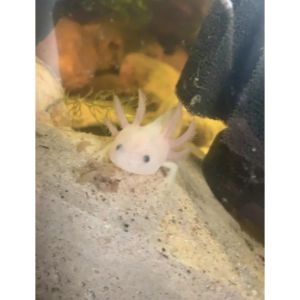
Similar to other axolotl variants, the average size that an enigma variant can reach is around 11 to 12 inches in length.
It’s important to note that this measurement represents the typical average length.
The size your enigma axolotl attains as an adult will depend on various factors, including the quality of its diet and the level of care it receives.
You can help support your enigma axolotl’s healthy growth and development by providing proper nutrition and ensuring optimal care.
Setting up Aquarium for Enigma Axolotl
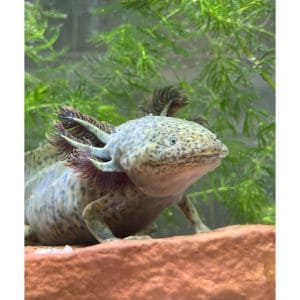
Tank
When housing an enigma axolotl, the minimum tank size recommended is 29 gallons.
However, it’s important to note that this is the bare minimum requirement.
Opting for a larger tank is preferable, with a 40-gallon tank being considered ideal for an enigma axolotl.
There are two primary reasons why a larger tank is beneficial.
- Firstly, axolotls have a rapid growth rate, and it is impractical to start with a smaller tank and later transition to a larger one. Therefore, it is more practical to begin with a larger tank right from the start.
- Secondly, enigma axolotls are known for producing a significant amount of bio-waste, resulting in the constant production of nitrates. If kept in a smaller tank, the water volume may not be sufficient to dilute the nitrates effectively, leading to rapid pollution of the tank. This issue is less likely to occur in a larger tank. While regular water changes are still necessary, maintaining acceptable water parameters will be easier. It is crucial always to keep the nitrate level below 20 ppm.
Regarding tank shape, choosing a more extended tank over a wider one is generally better.
A more extended tank with a larger floor space resembles the natural habitats of axolotls more than a more comprehensive tank.
It’s important to consider that axolotls can jump. It is best to maintain a water level that is moderately high to ensure the safety of your enigma axolotl.
Using a lid or cover for the aquarium can also help prevent your aquatic companion from accidentally harming itself.
Aquarium Cycle
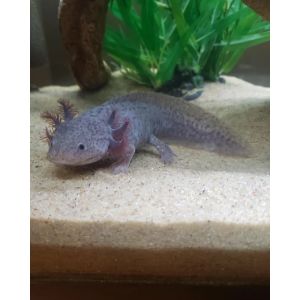
Having a fully cycled tank before introducing an enigma axolotl is crucial.
Cycling refers to establishing beneficial bacteria in the tank that help break down toxic substances like ammonia and nitrites, ensuring a stable and healthy environment for the axolotl.
It is best to wait until your tank has completed the cycling process before adding an enigma axolotl.
This waiting period can range from 4 to 12 weeks, as it takes time for the beneficial bacteria to establish and create a balanced ecosystem within the tank.
While it may require some patience, it is essential to take your time with the process.
A fully cycled tank provides a stable and safe environment for your enigma axolotl, promoting overall well-being and reducing the risk of stress or health issues.
Quality of water
Maintaining proper water parameters is crucial for the well-being of an enigma axolotl. Here are the recommended water parameters for an enigma tank:
Ammonia
Ideally, the ammonia level should be at 0 ppm. Ammonia is highly toxic to axolotls, so it must be effectively removed or converted by the beneficial bacteria in the tank.
Nitrite
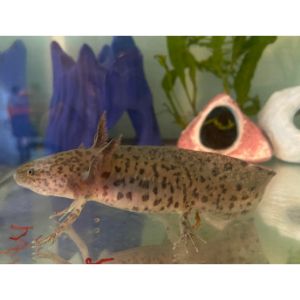
Similar to ammonia, the nitrite level should also be at 0 ppm. Nitrite harms axolotls and can cause health issues if present at elevated levels.
Nitrate
The nitrate level should be 5 to 20 ppm.
Nitrate is a byproduct of the nitrogen cycle, and although less toxic than ammonia and nitrite, high nitrate levels can still be detrimental to axolotls if not regularly managed through water changes.
pH Level
The tank’s pH should range from 6.5 to 8.0.
Axolotls can tolerate a slightly broad pH range, but avoiding extreme fluctuations or levels outside this recommended range is essential to ensure their health and well-being.
Regular testing of water parameters using reliable test kits is crucial to monitor and to maintain optimal conditions in the enigma tank.
You can adjust through water changes and appropriate filtration methods to maintain the desired levels.
Water Changes
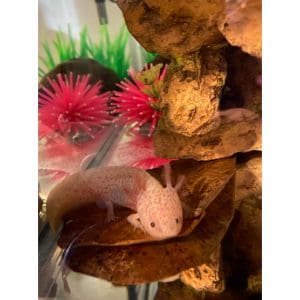
Due to their heavy bioload, regular water changes are vital when caring for an enigma axolotl.
Axolotls produce waste, which can lead to an accumulation of nitrates in the water over time.
It is best to perform partial water changes weekly to maintain a healthy environment for your enigma axolotl.
By conducting weekly water changes, you help remove excess nitrates, keeping their levels below 20 ppm to prevent any adverse effects on your axolotl’s health.
Regular water changes also help mitigate the risk of ammonia spikes, which can harm your enigma axolotl.
Water Conditioner
When performing water changes, it is essential to treat the new water with a suitable water conditioner to remove any chlorine or chloramine that could be present.
Maintaining a regular water change schedule is essential for promoting the well-being of your enigma axolotl and ensuring optimal water quality in the tank.
Temperature
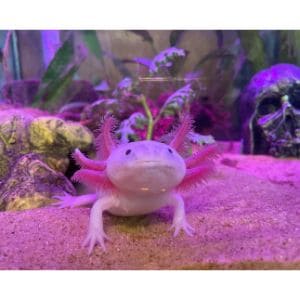
Creating a suitable environment that mimics the natural habitat of an enigma axolotl is crucial for their well-being.
A critical aspect of their habitat is maintaining a cool water temperature.
Axolotls are cold-water amphibians, and they thrive in cooler temperatures.
If the water temperature becomes too high, it can lead to stress, discomfort, and even health issues for the axolotl.
High temperatures can negatively impact their metabolism and overall physiological functions.
Conversely, if the water temperature drops too low, it can significantly slow down the axolotl’s metabolism.
While short-term exposure to lower temperatures may not cause immediate harm, prolonged exposure to consistently low temperatures can be unhealthy for axolotls.
Maintaining the water temperature within the appropriate range is recommended to ensure the optimal temperature for your enigma axolotl.
Typically, a temperature range of around 60-68°F (15-20°C) is suitable for axolotls.
A reliable aquarium thermometer and a heater or cooler, depending on the ambient room temperature, can help regulate and maintain the desired temperature in the tank.
By closely monitoring and controlling the water temperature within the appropriate range, you can provide a comfortable and healthy environment for your enigma axolotl.
Lighting
Axolotls, including enigma axolotls, are indeed sensitive to light. In their natural habitat, they are in dimly lit environments, such as lakes and ponds, with limited exposure to direct sunlight.
It is advisable to keep the lighting conditions in their tank low or even consider providing no lighting to provide a suitable environment for your enigma axolotl.
Excessive or bright lighting can cause stress to axolotls and may disrupt their natural behavior and rhythms.
Selecting a low-intensity and indirect lighting option is essential if you use lighting in the axolotl tank.
You can achieve this by using aquarium-specific low-light or subdued lighting fixtures.
Additionally, it is best to provide hiding spots and shelters, such as plants, caves, or decorations, which can further help create shaded areas for the axolotl to retreat and feel secure.
Creating a low-light or dimly lit environment can ensure a more natural and comfortable setting for your enigma axolotl, promoting overall well-being and reducing potential stress.
Substrate
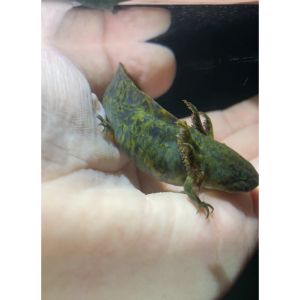
Using a substrate in an enigma axolotl tank is not a necessity. While a substrate can enhance the tank’s aesthetic appeal, it has specific considerations and risks.
Axolotls are known to be curious and may ingest anything they can suck into their mouths, including substrate materials.
That can lead to impaction, where the ingested material becomes lodged in the digestive system and causes blockages or other health issues.
If you choose to use a substrate in the tank, fine sand with a grain size of around 1 millimeter is generally considered a safer option, especially for larger enigma axolotls.
Axolotls are capable of passing small grains of sand without harm.
However, monitoring their behavior and ensuring they are not ingesting excessive amounts of sand is essential.
For smaller enigma axolotls, or if you want to eliminate the risk of substrate ingestion, using rocks as a substrate can be a suitable alternative.
Selecting rocks more significant than the axolotl’s head is essential to prevent them from swallowing or getting injured by the substrate.
Alternatively, going without a substrate is a valid option as well.
It simplifies the cleaning process and eliminates the risk of impaction from substrate ingestion.
To add visual appeal to the tank, you can incorporate tiles or other decorations that provide a stimulating environment for your enigma axolotl without the associated risks.
Ultimately, the decision to use a substrate or not should be based on the specific needs and behaviors of your enigma axolotl, considering factors such as their size and potential substrate ingestion risks.
Habitat
Providing hiding spots and incorporating live aquatic plants can significantly benefit the well-being of enigma axolotls and help create a more natural habitat for them.
Axolotls are known to be shy and enjoy having hiding spots where they can retreat and feel secure.
Adding hiding spots such as caves, rocks, or driftwood in the tank will allow your enigma axolotl to have places to hide whenever desired.
These hiding spots also serve as enrichment, providing opportunities for exploration and natural behaviors.
Live aquatic plants can enhance the aesthetics of the tank and provide additional benefits for axolotls.
They offer natural filtration, help maintain water quality, and can serve as other hiding spots.
However, selecting plants that can thrive in a low-lighting environment is essential, as axolotls are sensitive to bright light.
Several plant species, such as Java Fern, Anubias, and Java Moss, are suitable for low-light conditions.
These plants can tolerate lower light levels and provide a natural and calming environment for your enigma axolotl.
It’s essential to choose plants that are safe for axolotls and avoid any plants that may be toxic to them.
By incorporating hiding spots and suitable live aquatic plants, you can create a comfortable and enriching habitat for your enigma axolotl, promoting their natural behaviors and overall well-being.
Tank Mates for Enigma Axolotls
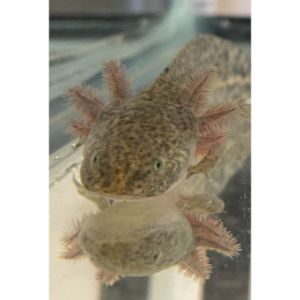
Enigma axolotls prefer to be kept alone in their tank, as introducing tank mates can lead to various risks and challenges.
The increased bio-load from other aquatic life can contribute to more rapid water pollution, which can be detrimental to the health of the enigma axolotl.
Furthermore, mixing enigma axolotls with other species, such as fish, can result in complications.
Infections, injuries, impaction, choking, and predatory behavior are potential issues that can arise.
Therefore, it’s essential to exercise caution and consider the compatibility and safety of any potential tank mates.
However, if you do wish to add tank mates to an enigma axolotl tank, there are some suitable options with proper consideration and monitoring:
Another Axolotl
Adult axolotls can coexist in the same tank, but waiting until both axolotls reach adulthood before introducing them to each other is essential.
Be careful to provide ample space and hiding spots to minimize territorial conflicts.
Mini Snails
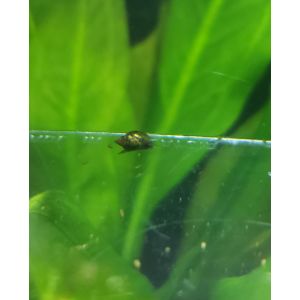
Certain species of tiny snails, such as Malaysian Trumpet Snails or Ramshorn Snails, can be compatible tank mates for axolotls.
These snails typically stay at the bottom of the tank and can assist in cleaning up waste.
Guppy Fish
Adult guppy fish can be considered tank mates for adult axolotls, but careful observation is necessary.
Choosing larger guppies is crucial to minimize predation risk and ensure the guppies are not nipping at the axolotl’s delicate external gills.
Regardless of the tank mates you choose, it’s essential to closely monitor their interactions and be ready to separate them if any signs of aggression or stress occur.
Regular water quality maintenance and adequate space for all inhabitants are crucial for maintaining a healthy and harmonious aquatic environment.
Remember, the primary focus should be on providing the best conditions for your enigma axolotl’s health and well-being, and introducing tank mates should be done carefully and cautiously.
Food and Diet
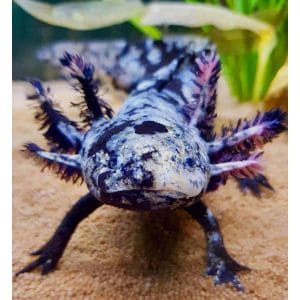
Enigma axolotls are carnivorous, and their diet primarily consists of small fish, freshwater insects, worms, and crustaceans in their natural habitat.
It’s important to avoid feeding them vegetables as they are not part of their raw diet.
Enigma axolotls are known to be cannibalistic, especially when food resources are scarce.
It’s essential to ensure that each axolotl in the tank has access to sufficient food to prevent aggressive behaviors and potential harm.
When feeding your enigma axolotl, you can provide them with suitable carnivorous options such as bloodworms, frozen brine shrimp, red wigglers (worms), or lean beef hearts.
These food options offer the necessary nutrients for their growth and overall health.
Providing varied and high-quality food sources is essential to ensure a balanced diet.
While observing your enigma axolotl during feeding can be exciting, avoiding overfeeding is crucial.
Overeating can lead to health issues, such as obesity and digestive problems.
Additionally, giving your axolotl enough time to digest its food is essential for its well-being.
Feeding schedules should be according to your enigma axolotl growth:
- Hatching and baby stages: Feed two times per day.
- Juvenile phase: Feed once a day.
- Sub-adult to the adult stage: Feed every other day.
- Mature adult stage: Feed every 2 to 3 days.
By following an appropriate feeding schedule and providing a varied and nutritious diet, you can help ensure the health and happiness of your enigma axolotl.
Remember to monitor their weight and adjust the feeding amounts to maintain their optimal condition.
Breeding Enigma Axolotls

Breeding enigma axolotls is unpredictable, as the enigma variant depends on chance.
It is a unique and rare creation, and intentionally reproducing enigmas is highly unlikely.
While breeding enigmas can happen, the offspring produced are unlikely to possess the enigma variant.
The cost of enigma axolotls is relatively high due to their rarity. On average, an enigma axolotl can be around $1,500.
Common morphs are available at a much lower cost, ranging from $30 to $50.
Finding enigma axolotls for sale is challenging due to their scarcity. With only a few sightings of the enigma variant, the opportunity to purchase one is minimal.
Consider yourself fortunate if you come across an advertisement for an enigma axolotl.
Although enigma axolotls are unique in their origin and appearance, their care requirements, tank setup, and diet remain the same as other axolotl morphs.
Providing them with the appropriate habitat, food, and care is essential for their well-being and health.
FAQs About Enigma Axolotl
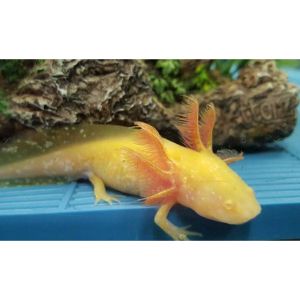
What is the rarest axolotl color?
The golden albino axolotl is considered one of the rarest colors among axolotls.
How rare are enigma axolotls?
Enigma axolotls are considered extremely rare due to their unique genetic variation. They are among the most sought-after and difficult-to-find variants of axolotls.
What is the rarest axolotl in the world?
The world’s rarest axolotl is the “Kiyoshi Golden Axolotl.” This variant features a stunning gold coloration and is in high demand among axolotl enthusiasts.
What is the rarest axolotl pattern?
The “Harlequin” pattern is one of the rarest axolotl patterns.
It is characterized by a unique combination of colors and markings, creating a striking and distinct appearance.
Are blue axolotls real?
No, blue axolotls do not occur naturally in the wild.
While there are various color morphs of axolotls, including albino, golden, and melanoid, true blue axolotls are not naturally occurring.
Blue axolotls available in the pet trade are typically the result of selective breeding and genetic manipulation to achieve the desired blue coloration.
The Ultimate Guide To The Enigma Axolotl
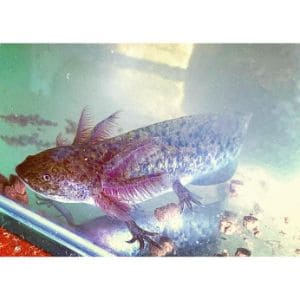
In conclusion, axolotls are fascinating and unique creatures with various morphs and color variations.
While some colors and patterns are rarer than others, the beauty and rarity of specific axolotl variants make them highly sought after by enthusiasts.
From golden albino and enigma axolotls to irregular patterns like a clown, these remarkable amphibians continue to captivate people worldwide.
Whether you’re a seasoned axolotl keeper or simply an admirer, the diversity and allure of these creatures make them truly special in the realm of aquatic pets.
If you find this guide, “The Ultimate Guide To The Enigma Axolotl,” informative and helpful, you can check out these other animal-related articles from our team:
You can learn more about axolotls by watching “All the Axolotl Breeds , Colors & Morphs [ Videos ]” down below:

